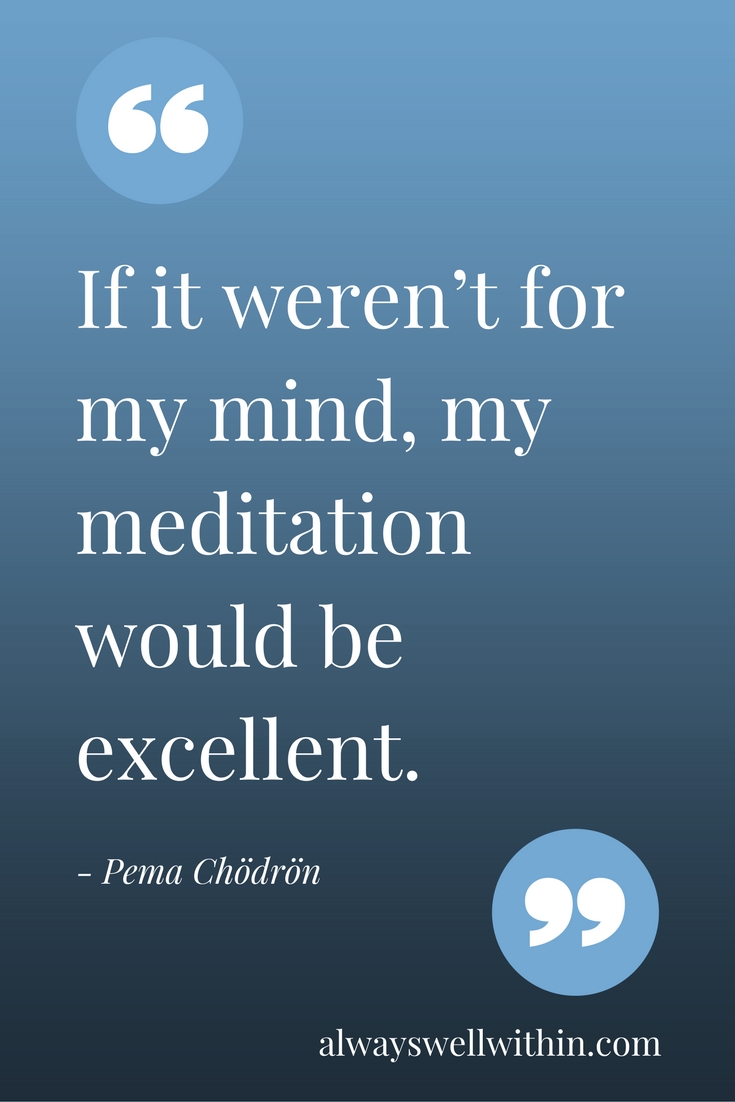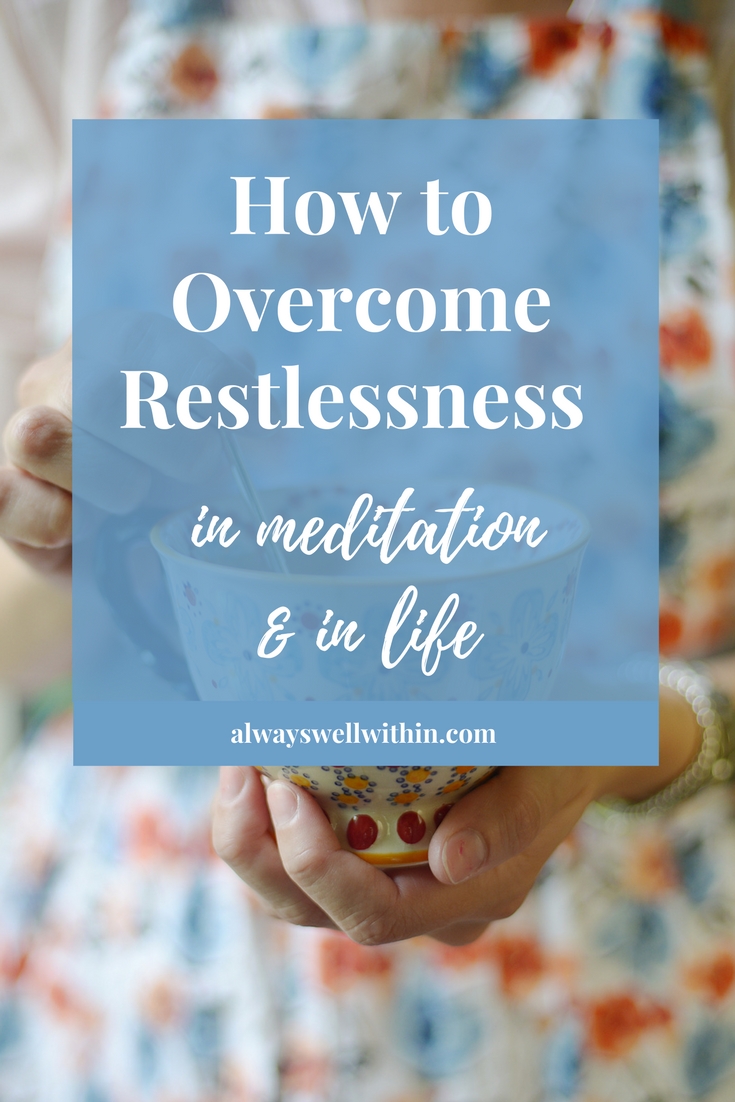How to Overcome Restlessness in Meditation and in Life
[Update: April 10, 2023]
We live in a speedy, restless age. So much so that constant agitation can change your physiology, causing you to be even more prone to edginess.
As a result, as much as you might desire to do so, trying to sit still for a few minutes of peace can feel like torture:
Your mind races with uncontrollable thoughts.
You can’t get comfortable.
You can’t sit still.
You notice every itch and minor discomfort.
You feel compelled to get up.
Your must-do list calls to you like a Siren.
You wonder, again and again, when your ten minutes will be over.
You feel anxious, excited, distressed or overcome by other emotions.
You try too hard and then feel more stressed.
You begin to judge yourself for your restlessness.
Generally, the remedy for restlessness in meditation is discipline.
Instead of reacting to restlessness by jumping up, you simply notice it. When you simply noticing restlessness without responding to its demands, again and again, it will gradually lose its power.
This works beautifully for some. But it doesn’t work for everyone.
Why not?
Because the physical and the subtle body might be disturbed in a deep and fundamental way that doesn’t allow you to just notice restlessness and not respond.
Frustrated and discouraged, you may give up on meditation altogether as impossible and continue in non-stop life activity, just making yourself more and more keyed up.
But it’s not impossible to find the peace you need, desire, and deserve.
You can use the simple practice of “vase breathing,” which can calm your mind and heart.
Pema Chodron Quote | Restlessness | Mindfulness Meditation
Getting to the Root of Restlessness
Instead of trying to force meditation, which never works, let’s take a deeper look at how to calm the fundamental disturbances within the subtle body.
I’m going to ask you to keep an open mind because you might feel we’re entering the land of woo-woo when I mention the “subtle” body. But bear in mind, the subtle body has been recognized for thousands of years by eastern medical and spiritual traditions.
If this approach has worked for meditators for thousands of years, why not give it a try.
According to the Tibetan Buddhist tradition, the subtle body is an invisible network within our being where the emotions live. Once established in the subtle body, emotional patterns impact the physical body and mental state in very real ways.
The subtle body consists of three components:
the tsa (channels)
the lung (wind or force)
the tigle (drops, droplets, or sparks of life)
You can imagine the channels as similar to the acupuncture meridians or the nervous system that extends throughout the body.
The drops or sparks of life are akin to neurotransmitters and travel through the channels.
They are carried by a force called the wind, which literally allows us to move physically, emotionally, and mentally.
The wind’s home base is located about 4 finger-widths below the navel. This is called the vase region in Tibetan Buddhism and is similar to the “dan tien” area spoken of in martial arts and qigong.
When the subtle body is in balance:
The channels are unobstructed
The wind is centered in its home and from there moves freely through the channels
The drops flow with ease
Do you remember a time when you felt well in your skin, a sense of lightness, joy, and openness?
That’s the subtle body in balance.
In contrast, you probably have days when you feel out of sorts, depressed, angry or anxious, perhaps for no clear reason at all.
That’s the subtle body out of balance.
Imbalances in the subtle body can accumulate and grow stronger and stronger over time, sculpting your thoughts, emotions, and behavior in unhappy and unhealthy ways and contributing to disorder and disease in the body.
One major type of imbalance occurs when the wind becomes agitated and starts to run too rapidly or erratically through the channels. This can come about when you’re endlessly seeking happiness outside yourself and constantly moving between hope and fear.
That’s when restlessness and speediness set in and can impact your whole life not just your meditation.
When there’s an imbalance in the wind, you may have trouble sleeping, get aches and pains, feel anxious and nervous, or suffer from exhaustion. Speediness breads speediness so it becomes harder and harder to relax the body, the mind, and the emotions.
Restlessness | Speediness | Meditation
How Can You Overcome Restlessness?
If you’re hampered by restlessness in meditation or in life, what can you do?
You can use a method called “vase breathing,” which brings the wind back to its home below the navel from where it can travel more smoothly through the channels.
This is the type of vase breathing associated with mindfulness meditation, not the more advanced practice of tummo inner heat meditation, which is more intense and energetic.
Because the mind rides on the wind, like a rider on a horse, when the wind is settled in its home, meditation happens more easily. Restlessness subsides as does excessive thinking and turbulent emotions.
You begin to feel a sense of space between your mind and your thoughts and emotions instead of being inseparably wed to them. Deep emotional patterns can begin to soften and gradually heal.
Here’s the practice of vase breathing in a few simple steps:
Sit comfortably with your spine straight but not rigid, allowing for its natural curve. Place your feet flat on the floor if you are sitting in a chair. Or you can sit with your legs crossed on a meditation cushion.
Begin by just noticing your breath for a few minutes without trying to change it. If your mind wanders, just bring it back to noticing the breath.
After a few moments, begin vase breathing. Start by exhaling slowly and completely. Gently bring the abdominal muscles as close to the spine as you can, but don’t use excessive force.
Next, breathe in slowly, allow your abdomen to expand, and imagine that you’re drawing the breath down to the area four finger-widths below the navel, the vase region. As you bring your breath and attention to this area, the wind will naturally follow and begin to rest there.
Hold your breath in the vase region for a few seconds. Then, before you feel any sense of urgency, slowly breathe out.
After exhaling and inhaling as above for three or four rounds, at the end of the last exhalation, try retaining a small amount of your breath, about 10% or whatever amount you can manage, in the vase region.
So that’s three or four rounds of breathing followed by one round where you retain a small portion of the breath in the vase region. Repeat the process — steps 3 through 6 — for about 10 minutes, always working with your breath in a gentle fashion. If you find 10 minutes challenging, start with 5 minutes or even 1 minute.
When you do this practice, you might feel calmer and more centered during or at the end of your first go. Or you might find it difficult or uncomfortable at first. Like any new skill, vase breathing takes practice.
If you find it challenging to work with your breath in this way, just begin by moving your attention from your head to the vase area below the navel and allow it to rest there. That will already begin to calm the wind and thus calm the mind and the heart. Then when, you feel ready, gradually begin to work with your breath as well as your attention.
When you practice vase breathing for 10–20 minutes each day, the winds will re-learn how to live in their home and travel smoothly through your channels rather than running about excessively. Slowly, you’ll be able to hold a small percentage of your breath in your vase region even as you go about your day.
This is an excellent way to begin your practice of mindfulness meditation. And if agitation arises during the day, you can practicing returning the wind to its home right on the spot.
“Mindfulness gives you time. Time gives you choices. Choices, skillfully made, lead to freedom.” – Bhante Henepola Gunaratana
Concluding Thoughts
Often, we blame or judge ourselves when challenged by emotional, mental, or physical patterns like restlessness, speediness, and worry. We don’t take into account how deeply these patterns have been embedded in our being through years and years of accumulated conditioning.
Restlessness could be considered a twenty-first century disorder. But there are solutions to a restless state of being.
The practice of vase breathing is specifically designed to calm a restless mind. It’s easy to do. If you stick with the practice, it can facilitate mindfulness meditation and help you feel calmer throughout the day too.
Peace is within your reach. By learning to work with your breath and thus the wind, you’ll find your center and feel at peace once again.
Important Note: If you live with anxiety, ADHD, or breathing problems, check with your psychotherapist or doctor first before engaging in a breathing practice like this.
Sources: I received in-person oral instructions on this practice from Tsoknyi Rinpoche. He later brought the instructions together in a chapter of his book entitled Open Heart, Open Mind: Awakening the Power of Essence Love.
Thank you for your presence, I know your time is precious! Don’t forget to sign up for Wild Arisings, my twice monthly letters from the heart filled with insights, inspiration, and ideas to help you connect with and live from your truest self.
You might also like to check out my Self-Care Shop. May you be happy, well, and safe – always. With love, Sandra





